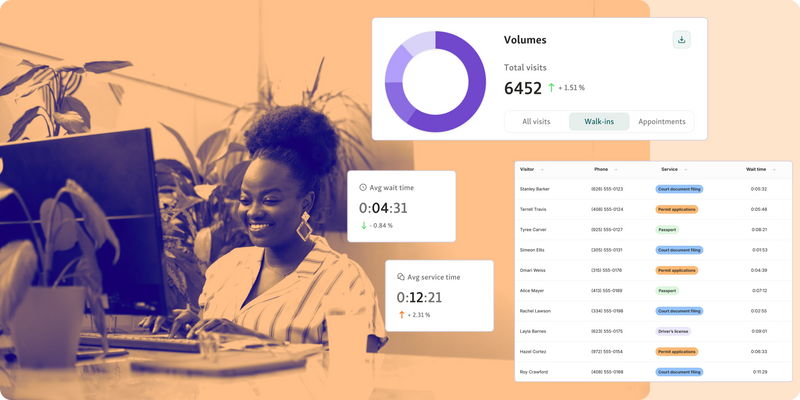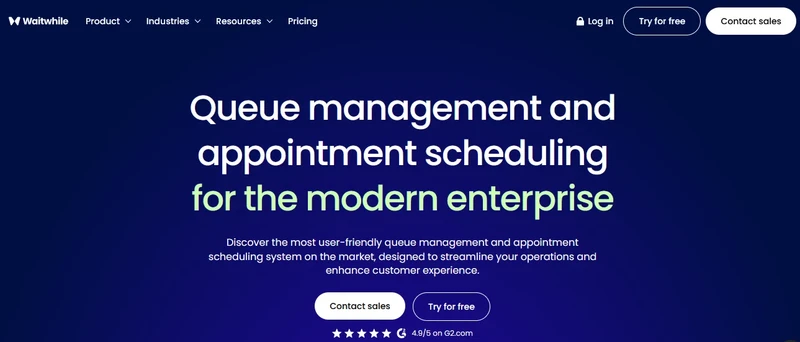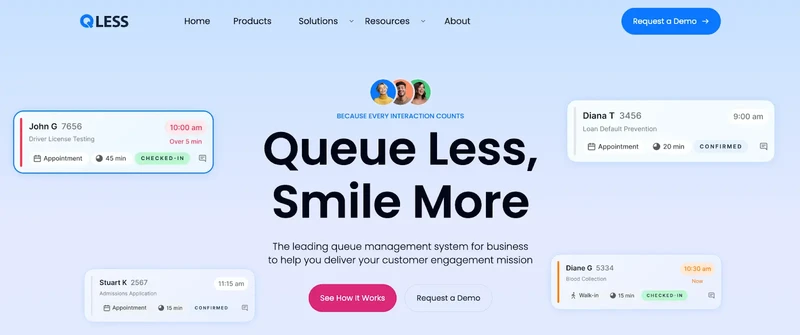Managing large numbers of daily visitors in government buildings is no easy task. Long queues, bottlenecks, and inconsistent service can quickly lead to frustration, for both staff and citizens.
That’s where visitor flow management powered by data analytics comes in. By using the top analytics tools, government offices can track, analyze, and optimize how people move through their spaces.
From identifying peak hours to predicting congestion, these insights help improve visitor flow and resource allocation in real time.
In this blog, we’ll explore the top analytics tools, including website visitor tracking software, that help public offices create smoother, more transparent, and efficient visitor experiences.
TL;DR (Quick Comparison Table)
Choosing the right analytics platform for visitor flow management in government buildings can feel overwhelming. This quick comparison table highlights 10 leading tools by core capabilities, use cases, and pricing, helping you find the best fit to improve efficiency, visibility, and visitor experience.
Tool | Best For | Key Analytics Features | Pricing |
Qminder | Government offices, hospitals | Real-time dashboards, multi-location analytics, staff leaderboards, and service reports | Starts at $389/month |
Vizitor | Public offices, hospitals, workplaces | Centralized dashboard, real-time visitor analytics, QR/mobile check-in, auto alerts | Starts at $36/month |
Qmatic | Large institutions, hospitals | Data Connect API, Power BI/Tableau integration, scheduled reports, wait-time tracking | Available on request |
V-Count | Public facilities, malls, campuses | BoostBI analytics, AI-based people counting, live occupancy, and queue alerts | Available on request |
Waitwhile | Public agencies, multi-branch setups | Custom report builder, peak-hour tracking, role-based dashboards, revenue insights | Starts at $0/month |
Qwaiting | Healthcare, public offices | Multi-level analytics (staff, branch, feedback), real-time visualization, BI integrations | Available on request |
Wavetec | Hospitals, clinics, government centers | BI dashboards, WhatsApp-based queuing data, real-time alerts, and feedback tracking | Available on request |
QLess | Healthcare, DMVs, government offices | AI-powered scheduling, callback queue analytics, employee performance metrics | Available on request |
Nemo-Q | Hospitals, education, public offices | Queue and feedback analytics, SMS/email updates, digital signage reporting | Starts at $290/month |
Qtrac | Large hospitals, multi-building campuses | Conditional alerts, drag-and-drop report builder, location analytics | Available on request |
Top 10 Analytics Tools for Smarter Visitor Flow Management
Here’s a curated list of the best visitor flow management and analytics tools that help government offices, hospitals, and public facilities track traffic patterns, optimize wait times, and improve the overall visitor experience.
1. Qminder

Qminder isn't just queue management, it's a complete visitor flow management and service intelligence solution for government offices, hospitals, and service centers. It helps teams nail visitor flow using real-time data, performance tracking, and smooth visitor interaction tools.
With Qminder's customer service analytics dashboard, managers track daily, weekly, and monthly metrics including wait times, service durations, and visitor counts. Regional managers compare locations, pinpoint bottlenecks, and make staffing calls based on hard data. Clerks get live queue visibility, managing visitors faster and delivering quicker service.
Key Features:
Compare visitor flow across locations from one screen
Track wait and service times to expose bottlenecks
Watch team performance through leaderboards and service reports
Pull daily, weekly, monthly analytics for strategic planning
Filter by location, service line, staff, or time period
One-click report exports for deep dives
SOC 2 Type II, HIPAA, and GDPR compliant security
Pros:
Analytics dashboard delivers live visitor data
Staff and managers both find it simple
Built for multi-location government and healthcare operations
Cons:
Smaller offices won't use every feature
Pricing: Free 14-day trial. Paid plans start at $389/month.
2. Vizitor

Vizitor is a smart visitor flow management platform that simplifies check-ins and optimizes movement in government offices, hospitals, and workplaces. Digital dashboards replace manual logbooks, tracking visitors live while helping organizations nail visitor flow and maintain safety minus the paperwork.
The centralized dashboard lets staff monitor visitor traffic across locations, access real-time analytics, and pull visitor history instantly. Pre-registration, mobile check-ins, and touchless QR codes create smooth, contactless experiences from entry to exit.
Key Features:
Centralized dashboard manages multiple locations and visitor data
Real-time analytics track visitor patterns and behavior
Web and mobile check-in via QR code or OTP
Automatic alerts flag overstays or missed check-outs
Bulk employee import and visitor directory simplify management
Export visitor logs and reports as CSV files
Cloud-based dashboard works from anywhere
Pros:
Staff and visitors both find the interface simple
Real-time insights cut congestion and improve visitor flow
Solid multi-location support for big organizations
Cons:
Complex integrations might need extra setup help
Lower-tier plans limit custom branding options
Pricing: Starts at $36/month.
3. Qmatic

Qmatic delivers advanced visitor flow management and analytics for massive public offices, hospitals, and government facilities. The platform attacks visitor flow problems and waiting frustrations by connecting every journey step, appointment booking to service feedback, through integrated dashboards and BI tools.
Their real-time dashboard reveals visitor activity including wait times, total served, and no-shows. Data Connect API integrates with Power BI and Tableau, opening up 70+ data points for operational deep dives.
Key Features:
Live dashboard tracking wait times, service duration, queue status
Reports export as PDF, CSV, XLSX files
Data Connect API links with Power BI, Tableau, QlikView
Cross-location branch and staff comparisons
Appointment tracking plus NPS monitoring for experience tuning
Reports schedule and send automatically
Compliance-ready infrastructure locks down data
Pros:
Analytics and integrations dominate for big institutions
Visitor behavior and staff metrics get exposed
Covers healthcare, public sector, finance verticals
Cons:
Technical expertise required for advanced setup
Smaller teams find the interface intimidating
Pricing: Available upon request.
4. V-Count

V-Count mounts ceiling sensors paired with BoostBI analytics for precise visitor flow management in public buildings. Their Nano AI sensors leverage 3D stereo vision plus on-device AI, anonymously tracking visitors at 99% accuracy, filtering out staff at 90%, determining gender at 95% and age at 80%, all without storing images for GDPR compliance.
Live occupancy data, queue alerts, and multi-location dashboards transform how agencies handle visitor flow and staffing decisions instantly.
Key Features:
99% precise people counting including groups, staff filtering
Live occupancy tracking, queue alerts, street traffic metrics
BoostBI mobile/web delivers real-time KPIs and site comparisons
Connects via APIs (POS, Power BI, Shopify) and REST endpoints
Nano hardware specs: night vision, IP65 rating, wide FOV, Wi-Fi ready, plug-and-play, USB-C powered, no batteries
Privacy-first approach: processes AI locally, stores zero images (GDPR ready)
Pros:
Hardware/software combo engineered for precision at scale
Excels outdoors and in darkness (night vision, IP65)
BoostBI turns data into action: occupancy patterns, dwell analysis, trend spotting
Cons:
Installation demands facilities team involvement
Recognition features require optimization work
Pricing: Available upon request.
5. Waitwhile

Waitwhile runs visitor flow management and analytics for industry leaders like Samsung, Louis Vuitton, and the U.S. Air Force. It fuses queue management, appointment scheduling, and live data analytics into one system that actually improves visitor flow.
Their analytics engine exposes everything, wait times, staff performance, visitor patterns across every location. Managers craft custom dashboards, schedule automated reports, tie metrics straight to revenue. Using website visitor tracking software-style visuals plus flexible APIs, Waitwhile makes data drive decisions.
Key Features:
Live queue analytics expose daily/weekly performance
Cross-location comparisons reveal trends
Report builder automates exports on schedule
Peak-hour tracking stops bottlenecks before they form
Revenue tracking links operations to profit
Role-based access splits data by staff level
APIs connect CRM, Power BI, Tableau
Pros:
Dashboards balance simplicity with customization
Analytics prove efficiency equals profit
Built for multi-branch government and public operations
Cons:
Report customization demands training time
Pricing: Starts at $0/month.
6. Qwaiting

Qwaiting is a cloud-based visitor flow management platform popular across public sector and healthcare environments that need virtual queuing plus rich analytics. It helps improve visitor flow with mobile, web, or kiosk check-ins, real-time queue status, and multi-branch oversight, all surfaced in an easy, centralized dashboard.
Managers get live visualization of wait times, customers being served, and totals, then drill into reports to spot peak hours, best-performing services, and staff efficiency.
Key features
Real-time visualization of key metrics (current wait, being served, total served) in one dashboard
Monthly, category, staff performance, feedback, and branch comparison reports
Filters by staff, counter, walk-in vs. appointment; includes missed/served/pending/canceled tracking
Data exports (PDF, Excel, HTML, CSV) and Data Connect API for BI integrations
Multi-location management to compare branches and make location-specific decisions
Pros
Strong analytics coverage from frontline ops to multi-branch strategy
Useful segmentation (category/staff/counter) to guide resourcing and training
Cons
Advanced customization may depend on plan level
High-volume mobile usage may need optimization and tuning
Pricing: Available on request.
7. Wavetec

Wavetec offers Spectra, an enterprise-grade visitor flow management and queue analytics platform that helps healthcare organizations improve visitor flow from arrival to feedback.
Designed for hospitals, clinics, and government facilities, Spectra connects appointment booking, virtual queuing, WhatsApp registration, and self-service kiosks into a single, intelligent ecosystem. Its website visitor tracking software-style dashboards provide real-time visibility into every interaction, helping staff make faster, data-driven decisions.
Key Features
WhatsApp-based appointment booking, queuing, and feedback collection
Self-service kiosks for check-in, billing, and information access
Interactive digital signage to guide patients in real time
AI- and BI-powered dashboards for queue and performance analytics
Feedback reporting to track NPS and satisfaction across departments
Real-time alerts and reporting for staff optimization and flow control
Pros
AI-driven analytics and dashboards enhance operational visibility
Scalable across hospitals, government offices, and public facilities
Cons
Requires installation and coordination for kiosk or signage setup
Initial configuration can be complex for smaller facilities
Pricing: Available on request.
8. QLess

QLess is a powerful visitor flow management and virtual queuing solution used across healthcare, government, and DMV offices to improve visitor flow and service efficiency. With a cloud-based platform that combines scheduling, communication, and analytics, QLess eliminates physical waiting lines through its smart website visitor tracking software-like dashboards and real-time queue insights.
Key Features
Two-way messaging between patients and staff for smooth, instant communication
Callback queuing that lets patients wait remotely and return when called
AI-powered scheduling for accurate wait time prediction and workload balancing
Real-time operational insights to identify bottlenecks and improve service delivery
Employee performance analytics to track efficiency and customer satisfaction
Role-based dashboards with live updates across multiple departments or branches
Pros
Reduces in-person congestion through virtual and callback queuing
Strong AI-driven analytics and reporting to optimize resource allocation
Cons
Callback workflows can require additional staff coordination
May be feature-heavy for small single-location clinics
Pricing: Available on request.
Read more - Top 10 Qless Alternatives for a Queue Management System
9. Nemo-Q

Nemo-Q delivers reliable visitor flow management and queue analytics for healthcare, government, and education facilities. It merges online scheduling, digital signage, and mobile alerts to smooth out every visitor interaction and improve visitor flow.
Patients or visitors check in through kiosks, QR codes, or phones. Staff watches real-time dashboards to track performance, shift resources, and control wait times.
Key Features:
Check-in options: kiosk, mobile, web with QR ticketing
Digital signage shows queue status, ticket numbers, directions
Real-time alerts plus SMS/email updates on wait times
Post-visit feedback collection and reporting built in
Custom dashboards for queue metrics, staff performance, throughput
Historical and real-time reports export to Excel, PDF, CSV
Pros:
Blends virtual, in-person, and hybrid queuing smoothly
Scales across departments and branches easily
Cons:
Setup can be complex for smaller organizations without dedicated IT teams
Regional language support could be improved for non-English interfaces
Pricing: Starts at $290/month.
10. Qtrac

Qtrac is an enterprise visitor flow management platform engineered to improve visitor flow across complex hospital layouts and multi-building campuses. It combines virtual queuing, appointments, mobile/SMS check-ins, and real-time analytics.
Patients join via QR, SMS, kiosk, or walk-in and track status without jamming lobbies. Operations teams get live dashboards, conditional alerts, and historical reports to rebalance staff and eliminate bottlenecks, like website visitor tracking software dashboards but built for physical traffic.
Key Features:
Queue re-routing between departments keeps visits moving
Real-time dashboards alert when KPIs breach thresholds
Greeter mode pre-screens and assigns patients at front desk
Offline mode maintains service during outages (syncs later)
Drag-and-drop report builder plus productivity/experience templates
Location analytics roll up local, regional, and enterprise data
Pros:
Handles multi-touchpoint, multi-department hospital flows
Instant patient redirection and live alerts slash bottlenecks
Cons:
SMS/texting feels sluggish for some users
Workflows confuse less tech-savvy patients or teams
Pricing: Price available on request.
Also Read - 32 Best Virtual Queue Systems – Free & Paid
Turning Data Into Better Visitor Experiences
Picking the right visitor flow management and analytics tool transforms how your organization runs. Cut wait times, predict service peaks, improve visitor flow, optimize staffing, and make data-driven moves with confidence.
Several top analytics tools bring solid capabilities to the table, but Qminder delivers something special, simplicity, scalability, and live insights that blend website visitor tracking software intelligence with on-site service smarts.
Ready to streamline operations and create experiences that actually work? Book a Qminder demo today.
Analytics tools monitor live visitor movement, wait times, and staff performance. Facility managers spot bottlenecks instantly, adjust staffing on the fly, and clear congestion across service areas.
Hunt for real-time dashboards, queue analytics, mobile check-ins, and smooth integration with existing systems. Security compliance and multi-location support matter big time for government operations.
Yes. Modern visitor flow management systems like Qminder plug into CRMs, scheduling software, and BI dashboards. You get unified reporting and operations that actually flow together.






